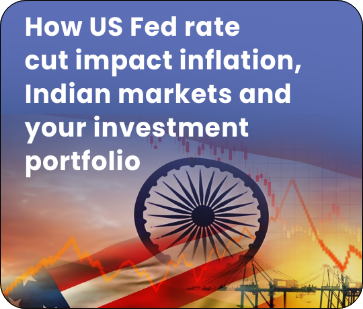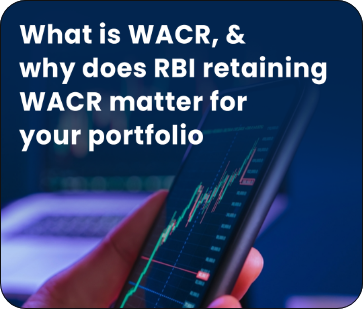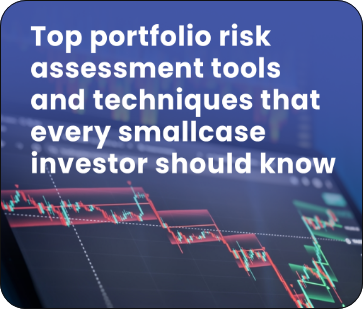
Retail Inflation 101: How Your Grocery Bills Shape India's Economic Outlook?
Every time you walk out of a supermarket wondering, "Was it always this expensive?", you're not just having a personal finance crisis.
Basically, you're reading India's macroeconomy in real time.
That ₹5 increase in milk. The sudden spike in tomatoes. The quiet drop in pulses. These aren't just numbers, they're signals.
Collectively, your grocery bill is one of the strongest indicators of where the Indian economy is headed next.
This is retail inflation, where the price of onions can sway stock markets, policy decisions, and even election outcomes.
While inflation sounds like an economist's abstract buzzword, it's anything but. It's personal. It shapes your spending, your savings, and your sense of financial control.
In this article, we break down what retail inflation really is, why food prices matter more than you think, and how those day-to-day changes in your basket are shaping the investor sentiment, and the overall impact on stock markets.
Table Of Contents:
Understanding retail inflation
Retail inflation (CPI-based) is the benchmark for price stability in India.
In fiscal year 2024-25, the average was 4.6% ,the lowest since 2018-19, and April 2025 inflation was only 3.16% year-on-year.
These rates are well below the RBI's comfort zone of around 4%. In March 2025, CPI dipped to 3.34%, and analysts see these trends as signals that price pressures are easing.
The CPI basket includes food & beverages, fuel, clothing, housing, health, education, and more.
The headline CPI number is what really hits your everyday wallet – it shows how petrol, rent, and groceries affect the average household. High inflation erodes purchasing power, while low inflation means budgets can stretch further.
Why are food prices essential?
Food prices are the engine of India's CPI. In fact, food and beverages account for nearly half of the CPI weight. That's because a large share of a typical family's income goes to staples.
A swing in vegetable or cereal prices quickly ripples through the inflation rate.
For example, if tomato prices surge, even urban consumers feel it at the checkout, and overall CPI jumps.
Movements in your grocery bill thus powerfully sway headline inflation. With about 46% weight in the index, food can lift or drag overall inflation more than any other category.
Governments know that interventions like building buffer stocks and subsidizing staples have helped keep food price rises in check.
That big weight reflects in reality as well. In many Indian households, especially rural and lower-income ones, most income is spent on food.
But it also means food prices are volatile: a good monsoon and bumper harvests can send vegetable prices plunging, pulling CPI down, while a drought or global shock can spike them.
The RBI tracks both "headline" CPI and core inflation (ex-food and fuel), but for everyday budgets, the headline number is what matters most.
The impact of retail inflation on consumption trends and households?
Inflation doesn't impact everyone equally, but it affects everything eventually.
Even though urban food inflation touched 11.1% in late 2024 and rural stayed slightly lower at 10.7%, the economic shock is uneven.
Essentials become unaffordable
Essentials like pulses, cereals, and vegetables become unavoidable, yet increasingly unaffordable.
Drop in non-essential consumption
Consumption of packaged foods and non-essentials drops sharply.
Rural demand slows
Rural demand, already fragile post-pandemic, slows down even further.
Economic consequences
The result? Mass demand softens. Businesses see slower turnover. MSMEs lose pricing power. Growth narratives begin to wobble.
Inflation trickles down as erosion of demand, and that's what stings the most.
The best way to beat the retail inflation is to choose the best smallcase company offering a diversified smallcase portfolio to mitigate risk and accommodate market volatility.
How does retail inflation shape stock market sentiment?
Inflation isn't just a household concern. It echoes through financial markets, too. In India, a higher-than-expected CPI often alarms investors, as it raises the odds of an RBI rate hike.
Costlier loans for companies and consumers can slow growth and squeeze corporate profits, putting downward pressure on stock valuations.
On the flip side, cooling inflation can be a green light for markets. The falling inflation in early 2025 raised hopes of RBI rate cuts, which would boost demand and liquidity.
Also, Reuters reported that "cooling domestic inflation will allow the central bank to ease interest rates further, and that, in turn, will boost both economic growth and corporate profits".
We saw this effect after April 2025's CPI reading. Bond yields fell sharply, lowering borrowing costs, and stock indexes often rallied.
Export-oriented sectors like IT jumped on expectations of a weaker rupee and stable input costs, while banks and real estate gained on the prospect of cheaper credit.
What should investors do in high-inflation periods?
High inflation calls for smart positioning. Historically, equities have offered good protection against rising prices.
Stocks are often the best inflation hedge – companies with pricing power can raise prices and maintain profits, so share values tend to keep pace with inflation over time.
Consumer staples, energy, and tech stocks typically fare better in inflationary times.
Here are some other strategies you should consider:
Commodities and Gold
Traditional hedges against inflation. Gold and industrial commodities usually appreciate when prices rise.
Inflation-Protected Bonds
Steer clear of long-term fixed-rate debt. Instead, look for CPI-linked government bonds or floating-rate notes. CPI-linked bonds are much better hedges than fixed bonds in high-inflation periods.
Shorter Durations
If you hold bonds or debt funds, favor shorter maturities or floating-rate funds, to reinvest at higher yields as rates rise.
Diversification and Rebalancing
Balance equities with other assets. Asset-allocation portfolios (mixing equity, debt, and gold) will automatically adjust to inflation shocks.
Pro Tip
You must consider growth-themed portfolios. For example, PINC Classic Compounder Fundamental smallcase targets promising companies expected to grow 15–20% over the next 3–5 years.
These businesses often withstand inflation better. Above all, avoid panic. Inflation comes in waves; a diversified, long-term strategy is your best shield.
Conclusion
Retail inflation, the change in prices of everyday goods, is woven into every household budget.
When it falls, families have more spending power and markets rally on hopes of rate cuts.
When it rises, wallets tighten and growth often slows. By watching grocery and fuel prices, consumers and investors get an early read on the economic tide.
We at PINC Wealth offer expert-driven, research-backed, and well-curated smallcase portfolios that respond to these realities, not just react to them. and help you achieve your financial goals against inflation. Start your investment journey today!
Related Articles

How will the US Fed rate cut impact inflation, Indian markets and your investment portfolio?
US Fed rate cuts influence Indian markets, currency trends, and smallcase stocks. Explore sectors that benefit, risks, and smart investment strategies for 2025.
Know more
What is WACR, and why does RBI retaining WACR matter for your portfolio?
Understand WACR and RBI's revised liquidity framework. Learn how these monetary policy changes impact your smallcase investment and portfolio returns.
Know more
‘Bite-sized’ smallcase investments: Low entry-cost portfolios for new and young investors
Making investment even easier and simpler with ‘bite-sized’ smallcase portfolios. Here’s a guide for beginners on how to start and build long-term wealth.
Know more
Top portfolio risk assessment tools and techniques that every smallcase investor should know
Learn about the top portfolio risk assessment tools and techniques that every smallcase investor should know to analyse and manage the potential risk, and how financial advisors help in this effectively.
Know moreMeet the people
we served!
PINC Compounder Smallcase has simplified my investment journey. Seriously, investing has never been easy for me! Here in a single click, I could access a balanced portfolio. Thanks PINC.
Mr. Akhilesh
I was hesitant about investing, but PINC Smallcase changed that. Talking to their team and looking at their growth gave me confidence. I've seen my investments grow steadily since then. I'm impressed!
Devendra Palan
As someone with limited knowledge about the stock market, I found Pinc smallcase to be a reliable and accessible platform. Their detailed reports and analysis have given me a deeper understanding of the stocks in my portfolio. I feel confident in managing my investments.
Pratik Gandhi

Subscribe to our email list
Sign up for Expert Insights
Your Gateway to Smarter Wealth
Management!
Looking to grow your wealth with
PINC Smallcase?